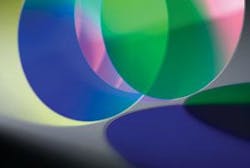For biologists, many discoveries depend on light moving—or not—through glass. To control that light, a scientist typically uses an optical filter. “Most of today’s biological optics are very specific about wavelengths,” says Michael Dent, president of Optical Filters USA (Medville, PA). “The filters should pass wavelengths over a very narrow band and cut off all of the light above or below that wavelength.”
Getting the right properties, though, depends entirely on a filter’s design. “For that, you need software,” says Iain MacMillan, director of coatings at Edmund Optics (Barrington, NJ). “There is commercial software available, and you can use it to create bandpass designs with upward of 100 layers—possibly more than 200.” In fact, a collection of technologies must be combined to make today’s high-end optical filters. (see “High performance with fluorescence optical filters,” p. 35.)
Creating a coating
The most common approach to coating a piece of glass relies on evaporation. In this process, an engineer heats up the desired coating material until it vaporizes in a vacuum chamber, and the evaporated material lands on the glass and coats it. “Many biological filters get made this way, but it can be difficult to accurately control the thickness of layers and to deposit high numbers of layers in a single coating,” says Turan Erdogan, Ph.D., chief technology officer at Semrock (Rochester, NY).
Moreover, filters made with evaporation can change over time. “Evaporative techniques can create filters that have properties that shift with changes in humidity and temperature,” says Markus Bilger, product line manager for high-precision filters at JDSU (Milpitas, CA). In addition, evaporative coatings can be “soft”—the material lets air or water into the coating, which can changes its optical properties. “It also makes these filters degrade over time,” Bilger says. “That turns such a filter into a consumable that must be replaced regularly—in a preventative-maintenance approach.” No research scientist, though, wants to buy a piece of equipment that needs regular replacement of the optical filters.For high-performance filters, Bilger recommends a different approach—coating through sputtering. JDSU produces filters with ion-beam and magnetron sputtering. Instead of evaporation, these techniques use an ion beam or a plasma, respectively, to basically knock molecules of coating off a source and onto a target—the filter.
Sputtering provides several improvements in coatings. For one thing, these filters usually let through 93% to 98% of the desired light, according to Craig Hanson, product manager at CVI Melles Griot (Albuquerque, NM). Filters made with evaporation, Hanson explains, only let through 75% to 85% of the light. In addition, says Hanson, “Filters made with sputtering provide a sharper transition from blocked to transmitted light.”
Semrock pioneered the use of ion-beam sputtering for biological filters. “This technique makes a very dense and stable coating,” Erdogan says. “It’s impervious to humidity and very reliable.” Layer thickness can be controlled, so many hundreds of layers can be placed. Erdogan says the coating’s optical properties can be just as good as those of the glass substrate.
Ongoing Improvements
Any component in an optical path—lenses, filters, and so on—can distort an image. To limit that distortion, scientists need optics with consistent properties. “With today’s hard filters,” says Erdogan, “distortion is not an issue. You are more limited by the glass substrate than the coatings themselves. So you need to start with homogenous, parallel, flat substrates.”
Not everyone, though, agrees that today’s coatings eliminate all distortion. Hanson notes that sputtering can create splatters that disrupt the uniformity of a coating and create distortion. “Maybe it’s just a 5 µm splatter,” Hanson says, “but you can sometimes get many of them.” Consequently, CVI Melles Griot inspects every filter by hand to ensure consistent quality.
MacMillan at Edmund Optics says that even though his company creates filters with the very accurate HELOIS sputtering system from Leybold Optics (Alzenau, Germany), he still insists on checking the product. “You must be able to measure accurately on the subnanometer level to see if the filter has the transmission and optical-density levels specified,” he says.
Beyond the characteristics and quality of a filter, it must also be affordable, which Bilger notes is one of the key challenges in today’s filter industry. “You have to be able to make these things cost competitively,” Bilger says. In some cases, cost pressure makes magnetron sputtering more attractive than ion-beam sputtering, according to Bilger. “Magnetron sputtering can produce filters at a higher throughput—especially when making high volumes,” he says.
Still, today’s price of optical filters limits the potential applications—maybe most of all in biomedical areas. Even a 1 in. filter can easily cost $250. For a lab-based device, such prices can be absorbed, particularly when the instrument gets used over years. But developers could create entirely new applications with less-expensive filters.
“We’re working on making high-quality, high-reliability filters at low enough costs for even clinical applications,” says Erdogan. So instead of hundreds of dollars, a filter might cost more like $10. “That can happen in the not-too-distant future,” Erdogan says. Then, companies might make fluorescent devices that could be used in a clinic or even be available over the counter for home health care. “For example, a simple fluorescence-based device could be made for looking at skin to monitor for melanoma,” Erdogan explains.
Future filters might do even more. “Tomorrow’s more-precise and lower-cost filters could also be smaller and able to perform multiple filtering task simultaneously,” says Kristin Vogt, product line engineer for filter products at Edmund Optics. As a result, filters could end up in places that we can’t even imagine today.
About the Author
Mike May
Contributing Editor, BioOptics World
Mike May writes about instrumentation design and application for BioOptics World. He earned his Ph.D. in neurobiology and behavior from Cornell University and is a member of Sigma Xi: The Scientific Research Society. He has written two books and scores of articles in the field of biomedicine.

